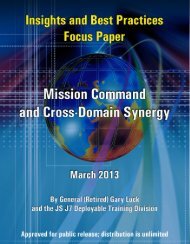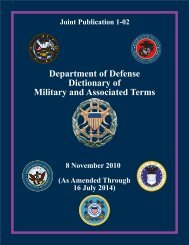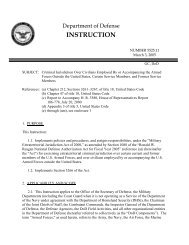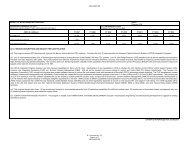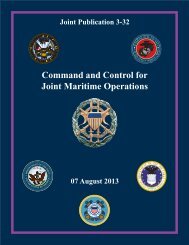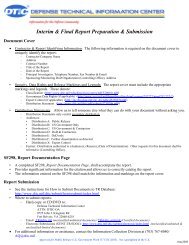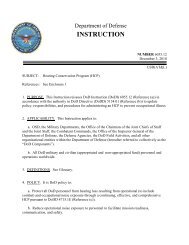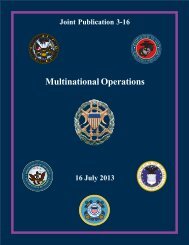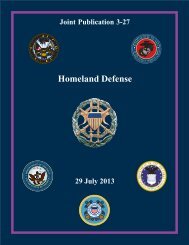JP 1, Doctrine for the Armed Forces of the United States - Defense ...
JP 1, Doctrine for the Armed Forces of the United States - Defense ...
JP 1, Doctrine for the Armed Forces of the United States - Defense ...
Create successful ePaper yourself
Turn your PDF publications into a flip-book with our unique Google optimized e-Paper software.
Executive Summary<br />
related capabilities and activities can be grouped. These<br />
groupings, which we call joint functions, facilitate<br />
planning and employment <strong>of</strong> <strong>the</strong> joint <strong>for</strong>ce. In addition<br />
to command and control (C2), <strong>the</strong> joint functions include<br />
intelligence, fires, movement and maneuver, protection,<br />
and sustainment.<br />
Joint Operation Planning<br />
Joint operation planning is<br />
<strong>the</strong> way <strong>the</strong> military links and<br />
trans<strong>for</strong>ms national strategic<br />
objectives into tactical actions.<br />
Law <strong>of</strong> War<br />
Joint operation planning provides a common basis <strong>for</strong><br />
discussion, understanding, and change <strong>for</strong> <strong>the</strong> joint <strong>for</strong>ce,<br />
its subordinate and higher headquarters, <strong>the</strong> joint<br />
planning and execution community, and <strong>the</strong> national<br />
leadership. In accordance with <strong>the</strong> Guidance <strong>for</strong><br />
Employment <strong>of</strong> <strong>the</strong> Force (GEF), adaptive planning<br />
supports <strong>the</strong> transition <strong>of</strong> DOD planning from a<br />
contingency-centric approach to a strategy-centric<br />
approach. The Adaptive Planning and Execution<br />
(APEX) system facilitates iterative dialogue and<br />
collaborative planning between <strong>the</strong> multiple echelons <strong>of</strong><br />
command. The combatant commanders’ (CCDRs’)<br />
participation in <strong>the</strong> Joint Strategic Planning System and<br />
APEX system helps to ensure that warfighting and<br />
peacetime operational concerns are emphasized in all<br />
planning documents.<br />
It is DOD policy that <strong>the</strong> <strong>Armed</strong> <strong>Forces</strong> <strong>of</strong> <strong>the</strong> <strong>United</strong><br />
<strong>States</strong> will adhere to <strong>the</strong> law <strong>of</strong> war, <strong>of</strong>ten called <strong>the</strong> law<br />
<strong>of</strong> armed conflict, during all military operations. The law<br />
<strong>of</strong> war is <strong>the</strong> body <strong>of</strong> law that regulates both <strong>the</strong> legal and<br />
customary justifications <strong>for</strong> utilizing <strong>for</strong>ce and <strong>the</strong><br />
conduct <strong>of</strong> armed hostilities; it is binding on <strong>the</strong> US and<br />
its individual citizens.<br />
<strong>Doctrine</strong> Governing Unified Direction <strong>of</strong> <strong>Armed</strong> <strong>Forces</strong><br />
National Strategic Direction<br />
Strategic Guidance and<br />
Responsibilities<br />
National strategic direction is governed by <strong>the</strong><br />
Constitution, US law, USG policy regarding<br />
internationally recognized law, and <strong>the</strong> national interest<br />
as represented by national security policy. This direction<br />
leads to unified action. National policy and planning<br />
documents generally provide national strategic direction.<br />
The national security strategy (NSS) provides a broad<br />
strategic context <strong>for</strong> employing military capabilities in<br />
concert with o<strong>the</strong>r instruments <strong>of</strong> national power.<br />
xii <strong>JP</strong> 1



